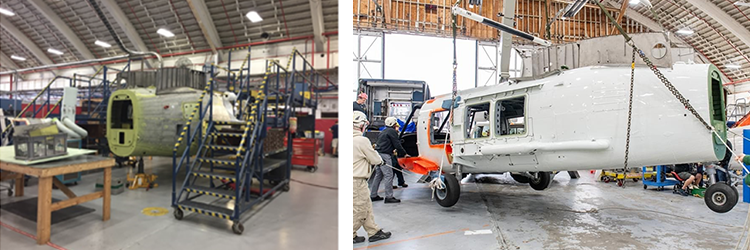The MH-60T is an all-weather medium range recovery (MRR) helicopter that provides multi-mission capabilities in support of Coast Guard and Department of Homeland Security missions. The MRR helicopter supports all statutorily mandated Coast Guard missions with specific emphasis on operations requiring rapid response and extended on-scene rotary wing aviation presence. It also conducts indirect support activities such as training and transportation of cargo and personnel.
The Coast Guard is conducting program activities to extend the service life of the existing MH-60T fleet as well as begin the transition to a rotary wing fleet consisting of all MH-60T aircraft.
Why this program?
Consolidation of the Coast Guard’s rotary wing fleet to a single MH-60T airframe is necessary to mitigate sustainability challenges with the MH-65 short range recovery helicopter and maintain the service’s rotary wing capability until recapitalization in line with the Department of Defense’s Future Vertical Lift program.
How will the Coast Guard increase and sustain the fleet?
The Coast Guard established a service life extension program (SLEP) in 2017 to extend the service life of the 45 MH-60T aircraft currently in the fleet. These helicopters have been in service since 1990; without the SLEP, 90% of the MH-60T fleet would reach the end of its service life by 2028.
As part of the SLEP, the Coast Guard is replacing the hulls of the legacy airframes with hulls from two sources: retired U.S. Navy H-60 aircraft and newly manufactured hulls procured from the original equipment manufacturer, Lockheed Martin/Sikorsky.
The Navy hulls are being converted to the MH-60T configuration at the Coast Guard Aviation Logistics Center (ALC) in Elizabeth City, North Carolina.

Left: Navy hull conversion in progress at the Coast Guard Aviation Logistics Center (ALC) in Elizabeth City, North Carolina. Right: A newly manufactured MH-60T hull being delivered to ALC. U.S. Coast Guard photos.
The program awarded an indefinite-delivery, indefinite-quantity contact in January 2021 for the production of new hulls – consisting of three fuselage structure sections: the nose, mid (cabin) and transition – that will be engineered, manufactured and delivered in the MH-60T configuration. Use of new hulls provides an airframe service life of 20,000 flight hours, compared to an average service life of approximately 12,000 flight hours for the previously used Navy hulls.
The remaining conversion activities – including replacement of dynamic components such as rotors and electrical rewiring – for all hulls will also be completed at ALC.
In October 2023, the Coast Guard received approval from the Department of Homeland Security to proceed with acquisition program activities that expand on the original SLEP to include a component for fleet growth.
The MH-60T Acquisition/Sustainment Program is authorized to:
- Move to full rate production of newly manufactured hulls as part of the SLEP for the existing MH-60T fleet.
- Conduct Obtain Phase activities and execute low-rate initial production of 12 new aircraft that will transition three Coast Guard air stations currently operating with the MH-65 to the MH-60T.
- Begin Obtain Phase activities for aircraft that will transition the remaining Coast Guard air stations to the MH-60T from the MH-65.
The SLEP is now known as Increment 1 of the program. To date, two aircraft have already completed SLEP activities. Delivery of new hulls 2 and 3 is scheduled for mid-2024. During full rate production, which starts with hull 4, deliveries should occur monthly. Forty-five new hulls are currently under contract.
The first fleet growth phase, known as Increment 2 of the program, will organically produce 36 aircraft to convert eight air stations from MH-65 to MH-60T operations. The program has been authorized to produce the first 12 aircraft for this increment and will seek authorization from DHS to produce the remaining aircraft at a later date. Transition of the first air station under Increment 2 is expected to occur in summer 2024.
The air stations not transitioned to MH-60Ts under Increment 2 will be converted as part of Increment 3 of the program. The final air station transition is anticipated to occur in the early 2040s.